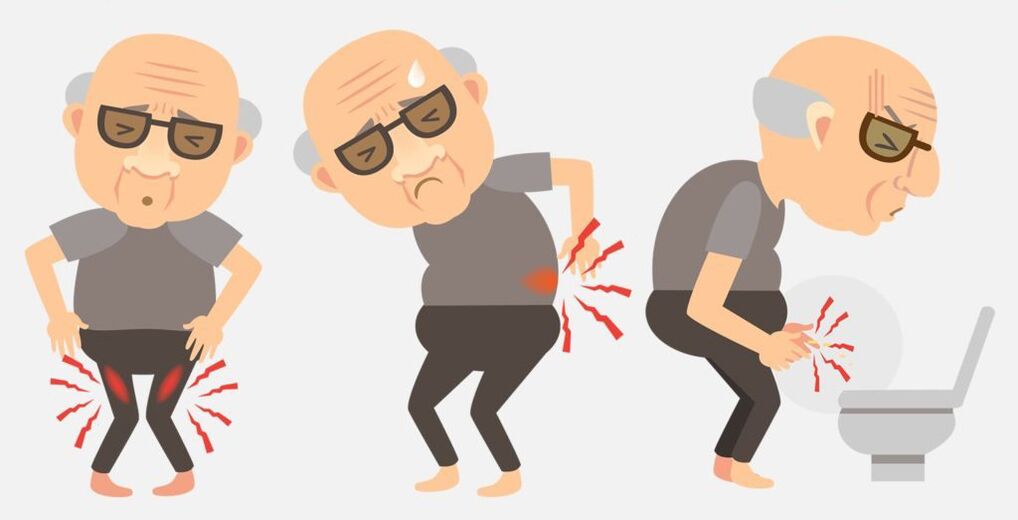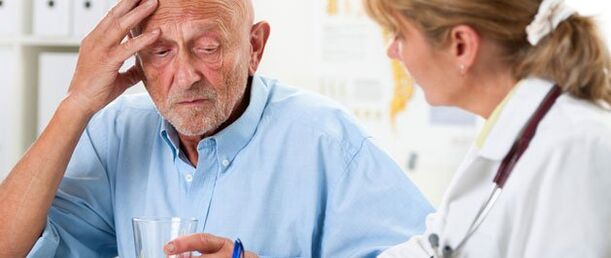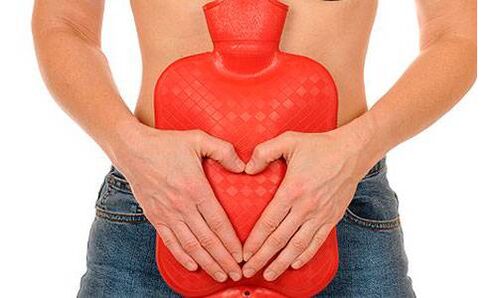Symptoms of prostatitis in men are not specific and specific, as it may seem at first glance. That is why in modern urology and andrology, infertility is increasingly diagnosed in men in the most active reproductive age - from 25 to 40 years old. The prostate gland in men is an organ that performs several functions: barrier, regulation of blood clotting, endocrine, reproductive, sexual (genital) intercourse, the role of bladder sphincter. The signs of prostatitis in men and its symptoms are varied, especially in the chronic form - they cover all organ functions and often make diagnosis difficult. .
Symptoms of acute prostatitis in men

What symptoms of prostatitis in men make you pay attention and go to the doctor? Every man, especially young and sexually active, needs to know about the signs of a lower genital tract infection and possible prostate cancer clinics. Many young people delay going to a urologist with the thought that this disease belongs to an older age.
Important.
Prostatitis is based on a complex of factors that begin to work precisely at the age of 20-30 years.
- Sexual infection is the first thing that triggers an active or sluggish inflammatory process. Chlamydia, mycoplasma infection, gonorrhea, trichomoniasis, tinea capitis initiate urethritis, which can therefore develop into glandular inflammation. Herpes simplex viruses, human papillomavirus, CMV, if they do not cause gland inflammation, aggravate STIs and "pave the way" for bacteria in the tissues of the organ. In the setting of genital infections, opportunistic flora (staphylococci, Escherichia coli) often lead to prostatitis. When diagnosed, mixed flora is often found.
- Working with sitting for a long time is one of the factors that give rise to the disease. Occupational hazards or habits that adversely affect prostate health.
- Erratic sex life - rare or random, psychological problems causing delayed or absent ejaculation, erectile dysfunction, frequent masturbation - dramatically disrupts the balance of arterial and venous blood flowcircuit in the line.
- The effect of cold on the lumbar region, abdomen and extremities - winter sports and recreation, occupational hazards associated with hypothermia, causing irreversible changes in the tissues of the gland.
Sexual infections, chronic hypothermia, stagnation of venous blood and prostatic secretions are the cornerstones of chronic prostatitis.. . . The symptoms of prostatitis have many forms, which are grouped into 3 syndromes: burning pain, painful urination and frequent urination (urinary disorder). The advantage of one of them is the reason to visit a doctor - urologist, sexologist, therapist or surgeon. The doctor's qualifications and qualifications will determine the speed of the healing process.
Acute prostatitis, the symptoms of which are observed after or simultaneously with an active genital infection, are characterized by the following:
- Discomfort and pain when urinating.
- Cut at the beginning or at the end of urination.
- Frequent and unwilling to go to the toilet.
- Pain around the anus, especially when sitting.
- Pain during bowel movements, feeling of fullness in the rectum.
- Mucus discharge from the urethra.
- Abdominal pain spreading to thighs, scrotum, back.
- Fever.
- Sexual dysfunction.
Each patient has a different severity of symptoms. In addition, only a certain symptom may predominate. But often the acute process takes place with few symptoms, which ensures frequent chronicity and an increase in the number of identified cases of chronic prostatitis.
The first signs of prostatitis
The onset of prostatitis symptoms occurs in young men under the guise of acute respiratory infection or as a classic genital infection. Depending on the type of pathogen, the signs of an acute process can be bright or clear.
Symptoms of prostatitis in men, initiated by gonococci, Staphylococcus aureus, Escherichia coli, as well as nosocomial infections (after manipulations on the urinary tract) are characterized by the following:
- The patient has sudden convulsions, chills, lasting from half an hour to two hours and ending with sweating.
- The temperature rises to 38 - 40 ° C.
- Characterized by weakness, severe weakness.
The first symptoms of prostatitis in men may not be accompanied by characteristic pain in the pelvic, rectal, and groin areas.. . . In addition, hypogonadism is not characteristic. In contrast, the early stages of catarrhal disease are manifested by overstimulation and premature ejaculation.
Important.
Urogenital Chlamydia, which often causes chronic prostatitis, is initially only mildly dyspeptic.
How is prostatitis manifested in men, starting with the penetration of flora into the prostate tissue by the bloodstream or the lymphatic system? This disease is accompanied by infectious diseases in general (sinusitis, pharyngitis, pneumonia, abscess, pustular skin disease) that the patient may not notice. Against the background of the underlying illness, the temperature rises again and the symptoms of intoxication also increase, mild indigestion and abdominal pain may develop.
Symptoms of chronic prostatitis in men

Chronic bacterial or viral prostatitis, congestive or infectious, the symptoms of which are different, are united by the fact that inflammatory processes, although due to different triggers, leads to three basic manifestations:
- Pain syndrome.
- Urinary disorders.
- Sexual dysfunction.
Prostatitis pain symptoms are also divided into three categories:
- Genitourinary tract - pain in the rectum, lower back, abdomen is characteristic.
- Symptoms of pelvic pain do not appear as such, but there is pronounced anal itching, tingling, paresthesia, neurological disorders, profuse sweating - this is due to the involvement of regional nerve plexusespots in the process.
- Genitals - pain in the scrotum, low back pain in the testicles, groin and perineum.
- Mix.
The pain symptoms in prostatitis form such a concept as "chronic pelvic pain syndrome in men. "
Symptoms of chronic prostatitis are accompanied by violations and inhibition of erection, ejaculation and decreased libido. In this context, a neurotic-like syndrome is formed, progressing according to either sympathetic or parasympathetic type. The first is characterized by attacks of heart rate, fever, nausea in the evening, sudden mood swings, inattention. For the second - drowsiness during the day, fatigue, insomnia at night, body weakness, sweating, weight gain, lumps in the throat, excessive salivation.
Among the dyspepsias, there are more frequent urination, difficulty emptying the bladder, dripping and bad voice. Such findings bear a strong resemblance to adenomas, sometimes complicating the diagnosis.
Important.
Chronic prostatitis in men after the age of 45 years often co-occurs with prostatic hyperplasia.
In the chronic form, hyperspermia and prostatic hypersecretion are observed - a phenomenon where the prostate gland secretes fluid from the urethra combined with semen due to loss of organ tone.
Asymptomatic prostatitis
Prostatitis is not always symptomatic. Often, a man learns about a disease, for example, when he makes an ultrasound diagnosis when planning a baby. They found calcifications in the tissues of the prostate, blocked ducts, enlargement or contraction of the gland, sclerosis, impaired blood flow on Doppler ultrasound, and plexus varices of the prostate and pelvis. small pots.
Symptomatic prostatitis develops in young men after genital infections, especially urogenital chlamydia and mycoplasmosis.In particular, prostatitis is often asymptomatic after inadequate and timely treatment of these diseases. Normally, when examining spermatozoa, a decrease in germ cell count, active motile cell count, agglutination and lecithin granule reduction is found. There may be periodic sexual failures, which the man does not take seriously.

Symptoms of an exacerbation of prostatitis
Exacerbation of chronic prostatitis develops with exposure to adverse pro-inflammatory factors - general somatic disease, hypothermia, irregular sexual activity, alcohol abuse, exacerbation of communicable diseasesInfection of the genital organs and rectum.
Symptoms of acute prostatitis in men are similar to the onset of the disease. An increase in temperature, general malaise, fatigue, weakness, chills are the leading signs. Swelling in the anus, feeling full of rectum, lower back pain in the groin, perineum is increasing. Sexual and neurological dysfunction is also aggravated. When going to the toilet, the patient noted difficulty and increased urination, weak flow, pain.
Features of the course of some types of prostatitis
How does prostatitis in men manifest in different forms? Usually, several types of diseases are distinguished, depending on the common process: infectious, bacterial, stagnation, pyogenic.
Prostatitis caused by infection and bacteria
This concept includes several unlearned forms of disease, or rather differentiated according to the types of pathogens that cause disease. Infectious prostatitis, the symptoms of which can only be caused by pathogenic bacteria and viruses, can be initiated by opportunistic pathogens and sexually transmitted. Conditionally pathogenic microorganisms that normally reside in the male urogenital tract cause disease only when adverse factors are encountered. Normally, when semen and urine culture will be found Escherichia coli, staphylococcus, enterococcus. This is a bacterial prostatitis.
Infectious prostatitis is overwhelmingly noted in young men.This type of prostatitis is often chronic and leads to infertility.
The clinical picture is characterized by the highest luminosity with gonorrhea, and with chlamydia, mycoplasmosis and opportunistic pathogens, the symptoms are rare, so it often leads to chronic prostatitis.

Purulent prostatitis
The pyogenic flora is represented by gonococci, Pseudomonas aeruginosa, Escherichia coli, methicillin-resistant Staphylococcus strains. These microorganisms secrete a number of destructive enzymes, which are characterized by aggressiveness towards the tissues of the prostate gland, and thus initiate purulent fusion.Most often, purulent prostatitis ends with an abscess, aneurysm, prostatitis, and posterior gland inflammation.
The process of pus formation is usually initiated by bacteria that have entered the prostate in the following ways:
- From purulent foci in other organs.
- For medical intervention in the genital organs. The nosocomial flora is characterized by resistance to many antibiotics, so it precisely leads to purulent prostatitis.
Purulent prostatitis, the most prominent symptom, often causes complications: urinary and intestinal fistulas. And these bacteria also easily invade the ascending route to the kidneys, pelvis and calyx, causing their chronic inflammation.
Congestive prostatitis
Isolated processes of this type of disease are practically excluded, since against the background of stagnant processes the microflora is attached, and the disease has an infectious form of course. Usually, urologists make such a diagnosis if no bacteria are isolated during the culture of the biomaterial. As a rule, an analysis performed after 2-3 weeks will give a positive result for the microflora.
Venous stasis is often observed with varicose veins, anorectal diseases, pelvic tumors, and hemodynamic compromise. Violation of the outflow of prostate secretion, which is often observed in sexual dysfunction and irregular sexual activity, leads to stagnation and preconditions for inflammation.Congestive prostatitis, the symptoms coincide with infection, are closely related and follow each other.Symptoms will be supplemented by varicose veins and rectal lesions.
Obviously, in the chronic form the manifestations of prostatitis can be nonspecific, requiring a thorough, comprehensive diagnosis.
Important.
Any sign of a genital infection in men should contact a urologist or a dermatologist for treatment.
Self-medication or ignoring the situation can be an impetus for the formation of a chronic form.
























